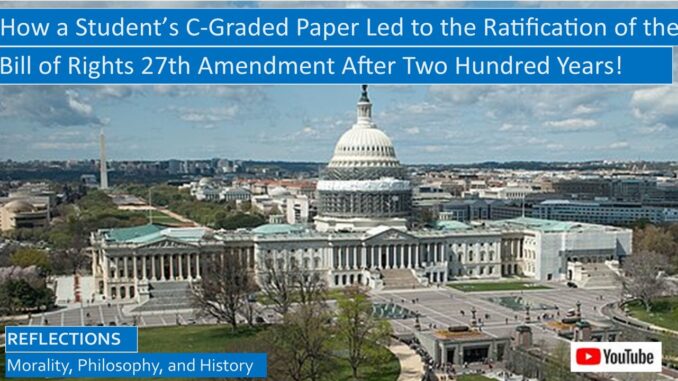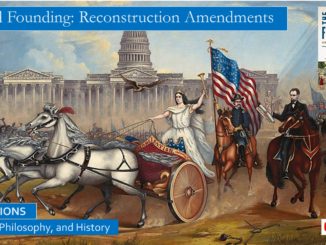
Why was the Bill of Rights 27th Amendment ratified over two hundred years after being submitted to the state legislatures?
How was a lowly student able to spearhead the passing of an amendment to the Constitution?
Was he ultimately successful in appealing the C-Grade on his paper on this unratified Bill of Rights amendment?
What other forgotten amendments can be successfully ratified?
THE CONSTITUTION AND THE BILL OF RIGHTS
Many citizens in the ratification conventions were wary that a strong federal government could trample on the rights of ordinary citizens, just as Great Britain had trampled on the rights of her American colonists before the Revolutionary War. The Constitution was ratified with the proviso that the first Congress would pass and submit to the states for approval a series of amendments, a Bill of Rights guaranteeing that the federal government would protect the basic freedoms of Americans. Based on suggestions offered in these conventions and in the national discussions, James Madison drafted a series of about twenty proposed articles for the states to approve, which were modified and condensed into proposed amendments by Congress.
Most Americans know there were ten amendments ratified by the states by 1792, only two years after Congress proposed them. This Bill of Rights included:
- Freedom of religion.
- Freedom of speech.
- Right to bear arms.
- No quartering of soldiers in private residences without consent.
- No unreasonable searches or seizures.
- No double jeopardy, you cannot be tried twice federally for the same crime.
- Right to a speedy trial, and to a jury trial in civil cases.
- No excessive bail or cruel or unusual punishments.[1]
Many people do not know that there were two Bill of Rights amendments drafted by James Madison and approved by Congress which were never ratified by the required three-fourths of the state legislatures in 1789. One of the amendments that had not passed had been suggested previously during the North Carolina and New York ratifying conventions.
This was the amendment concerning Congressional pay raises:
“No law, varying the compensation for the services of the Senators and Representatives, shall take effect, until an election of Representatives shall have intervened.”
In other words, no pay raises before elections.
This amendment was ratified by seven states by 1792, short of the number of states required. Another action taken by the first Congress was the admission of two new states: Kentucky and Vermont. Twelve states are the required three-fourths of fifteen, consisting of the original thirteen colonies plus the two new states. Much later, two other states ratified the amendment as a protest against Congressional pay raises: Ohio in 1873 and Wyoming in 1978.
This amendment was mostly forgotten until nineteen-year-old Gregory Watson submitted a paper in a government class at the University of Texas suggesting that it could still be successfully ratified, as the original Bill of Rights amendments had no deadline. The teacher’s assistant grading his paper ridiculed his research, saying that ratification would be totally implausible, giving the paper a C grade. He appealed the grade to the course instructor, Sharon Waite, who sided with the hapless teacher’s assistant.
PERTINENT SUPREME COURT RULINGS
What were the Supreme Court rulings on when proposed amendments expire? Dr Wikipedia informs us that “in Dillon v. Gloss, 256 U.S. 368 (1921), the Supreme Court remarked that ‘ratification must be within some reasonable time after the proposal,’ and suggested that it was ‘quite untenable’ to view proposed amendments from 1789, 1810, and 1861 as still pending.”
“But in Coleman v. Miller, 307 U.S. 433 (1939), the court ruled that the validity of state ratifications of a constitutional amendment is a political matter, and thus not properly assigned to the judiciary. It also held that for a political question, it was up to Congress to determine whether an amendment with no time limit for ratification is still viable after a long time based on ‘the political, social and economic conditions which have prevailed during the period since the submission of the amendment.’”
SUCCESSFUL QUIXOTIC QUEST FOR RATIFICATION
How could our lowly student Gregory Watson prove that ratification was a plausible quest? By starting a letter-writing campaign seeking ratification, eventually spending six thousand dollars of his own money on this quest.
As a first step, he wrote to select Congressmen, asking if they knew of any state legislator who would like to introduce a resolution passing this amendment. A congressman from Maine replied that one of his staff members, also a member of the Maine State Legislature, was interested in the quest. He introduced the ratification resolution, and it easily passed, giving our student credibility in his quest. Maine passed the amendment in 1983, followed by Colorado in April 1984. Over time, he was assisted in his quest by Ralph Nader, the Washington Post, and several congressmen and activists.
Nine years later, Michigan and New Jersey vied to be the thirty-eighth state to ratify the amendment in 1992. Over two hundred years after James Madison first drafted this proposal, this final Bill of Rights amendment was passed as the 27th amendment, a record-breaking ratification process!
In 2016, Professor Zach Elkins at the University of Texas became interested in this recent history, tracking down Sharon Waite, who left academia about a decade after Gregory was a student to work on her parent’s citrus farm. When asked about whether his grade was fair in hindsight, Sharon Waite said, “Goodness, he certainly proved he knew how to work the Constitution and what it meant and how to be politically active.” “So, yes, I think he deserves an A after that effort: A-plus!”
Elkins and Waite submitted a grade change form to change Gregory’s class grade to an A+! That same year, the Texas Legislature passed a resolution commending Gregory Watson’s efforts in spearheading the effort to pass this last amendment in the Bill of Rights. But regarding that teaching assistant, his name has been lost in the sands of history, as digging it up would serve no purpose.[2]
What was the twelfth proposed amendment of the Bill of Rights passed by Congress, but never ratified by the states? It was a complex amendment refining the ratio between Representatives and the population, with a maximum of one Representative for every fifty thousand constituents. Based on the 2020 census, this formula results in about 6,600 Representatives in the House, which is way too many Congressmen. The passing of this amendment is, indeed, implausible.[3]
There are a few outstanding amendments that theoretically could still be ratified. One is an 1810 amendment stripping citizenship from anyone accepting a title of nobility without Congressional approval, which means you cannot be the square foot of land to qualify as a Scottish Lord. Also open for ratification is the 1924 Child Labor Amendment, which enables Congress to directly regulate employment of children under eighteen years of age. Federal and state legislation eventually ended child labor by the New Deal era.[4]
We also reflected on the differences between the Articles of Confederation versus the Constitution, as amended by the Bill of Rights. This was the beginning of the tensions between states’ rights and federal power.
States’ Rights v Federal Power From the Nation’s Founding to Civil War, Jim Crow, and Civil Rights Movement
https://seekingvirtueandwisdom.com/states-rights-v-federal-power-from-the-nations-founding-to-civil-war-jim-crow-and-civil-rights-movement/
https://youtu.be/rebihRK4EPE
DISCUSSING THE SOURCES
Along with this reflection, we reflected on how the Constitution, plus the Bill of Rights, improved upon the Articles of Confederation. Our primary sources for this reflection are various articles collated by Dr Wikipedia, plus the YouTube videos and articles in the footnotes, including several live interviews with our famous student, Gregory Watson.
Many critics contend that this amendment accomplishes little. Although Congress previously passed legislation automatically increasing their pay each year by COLA, or cost of living adjustment, it has voted to decline this annual raise each year since 2009. Currently, the Congressional pay is $174,000 annually.[5]
Per Dr Wikipedia:
The following states have ratified the Twenty-seventh Amendment:
- Maryland – December 19, 1789
- North Carolina – December 22, 1789 (Reaffirmed on July 4, 1989)
- South Carolina – January 19, 1790
- Delaware – January 28, 1790
- Vermont – November 3, 1791
- Virginia – December 15, 1791
- Kentucky – June 27, 1792 (Reaffirmed on March 21, 1996)
- Ohio – May 6, 1873
- Wyoming – March 6, 1978
- Maine – April 27, 1983
- Colorado – April 22, 1984
- South Dakota – February 21, 1985
- New Hampshire – March 7, 1985 (After rejection on January 26, 1790)
- Arizona – April 3, 1985
- Tennessee – May 28, 1985
- Oklahoma – July 1, 1985
- New Mexico – February 14, 1986
- Indiana – February 24, 1986
- Utah – February 25, 1986
- Arkansas – March 13, 1987
- Montana – March 17, 1987
- Connecticut – May 13, 1987
- Wisconsin – July 15, 1987
- Georgia – February 2, 1988
- West Virginia – March 10, 1988
- Louisiana – July 7, 1988
- Iowa – February 9, 1989
- Idaho – March 23, 1989
- Nevada – April 26, 1989
- Alaska – May 6, 1989
- Oregon – May 19, 1989
- Minnesota – May 22, 1989
- Texas – May 25, 1989
- Kansas – April 5, 1990
- Florida – May 31, 1990
- North Dakota – March 25, 1991
- Missouri – May 5, 1992
- Alabama – May 5, 1992
- Michigan – May 7, 1992
On May 18, 1992, the Archivist of the United States, Don W. Wilson, certified that the amendment’s ratification had been completed. Michigan’s May 7, 1992, ratification was believed to be the 38th state, but it later came to light that the Kentucky General Assembly had ratified the amendment during that state’s initial month of statehood, making Alabama (which acted after Missouri on May 5, 1992) the state to finalize the amendment’s addition to the Constitution.
The amendment was subsequently ratified by:
- New Jersey – May 7, 1992 (After rejection on November 20, 1789)
- Illinois – May 12, 1992
- California – June 26, 1992
- Rhode Island – June 10, 1993 (After rejection on June 7, 1790)
- Hawaii – April 29, 1994
- Washington – April 6, 1995
- Nebraska – April 1, 2016
Four states have not ratified the Twenty-seventh Amendment: Massachusetts, Mississippi, New York, and Pennsylvania.[6]
[1] https://en.wikipedia.org/wiki/United_States_Bill_of_Rights
[2] https://en.wikipedia.org/wiki/Twenty-seventh_Amendment_to_the_United_States_Constitution and https://en.wikipedia.org/wiki/1792_United_States_presidential_election and https://www.youtube.com/watch?app=desktop&v=f8IUbYsd3y0 and https://supreme.findlaw.com/legal-commentary/the-telling-tale-of-the-twenty-seventh-amendment.html
[3] https://en.wikipedia.org/wiki/Congressional_Apportionment_Amendment
[4] https://en.wikipedia.org/wiki/List_of_amendments_to_the_Constitution_of_the_United_States
[5] https://supreme.findlaw.com/legal-commentary/the-telling-tale-of-the-twenty-seventh-amendment.html and https://en.wikipedia.org/wiki/Salaries_of_members_of_the_United_States_Congress
[6] https://en.wikipedia.org/wiki/Twenty-seventh_Amendment_to_the_United_States_Constitution




Be the first to comment